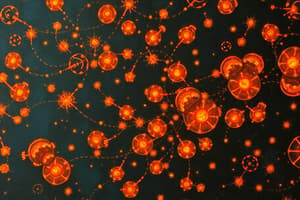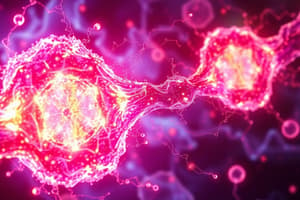Podcast
Questions and Answers
What is the role of a ligand in cell signaling?
What is the role of a ligand in cell signaling?
- It is a protein involved in direct physical interaction between cells.
- It is an enzyme that relays signals from the receptor to target genes.
- It is a signaling molecule that binds to cell surface receptors. (correct)
- It is a protein on the cell surface that recognizes and binds to receptors.
Which component of the cell signaling pathway recognizes and binds to ligands?
Which component of the cell signaling pathway recognizes and binds to ligands?
- Receptor (correct)
- Downstream signaling molecules
- Enzyme
- Ligand
In wired (cell-to-cell contact) signaling, how do cells communicate?
In wired (cell-to-cell contact) signaling, how do cells communicate?
- By relaying signals from receptors to target genes.
- Via adhesion molecules and gap junctions. (correct)
- By converting extracellular signals into cellular responses.
- Through signaling molecules traveling through the extracellular space.
What is the primary characteristic of wireless signaling pathways?
What is the primary characteristic of wireless signaling pathways?
What is signal transduction in cell biology?
What is signal transduction in cell biology?
Which component of the signal pathway relays signals from the receptor to target genes and pathways?
Which component of the signal pathway relays signals from the receptor to target genes and pathways?
What is the primary role of the Mitogen-activated protein kinase (MAPK) pathway?
What is the primary role of the Mitogen-activated protein kinase (MAPK) pathway?
How does the Phosphatidylinositol 3-kinase (PI3K)/AKT pathway impact cell physiology?
How does the Phosphatidylinositol 3-kinase (PI3K)/AKT pathway impact cell physiology?
Which statement accurately describes the Wnt signaling pathway?
Which statement accurately describes the Wnt signaling pathway?
How does dysregulation of cell signaling pathways contribute to disease progression?
How does dysregulation of cell signaling pathways contribute to disease progression?
What is the fundamental purpose of cell signaling in maintaining proper functioning?
What is the fundamental purpose of cell signaling in maintaining proper functioning?
Why is understanding cell signaling pathways crucial for developing targeted therapies?
Why is understanding cell signaling pathways crucial for developing targeted therapies?
Flashcards are hidden until you start studying
Study Notes
Discovering the Language of Cells: Cell Signaling 101
Cell signaling is a fundamental process that allows cells to communicate and coordinate with one another, ensuring the proper functioning of our bodies. This intricate dance involves a complex network of molecular events through which cells exchange information to maintain homeostasis, respond to environmental stimuli, and regulate various physiological processes.
The Signal Pathway Cast
- Ligand: A signaling molecule that binds to cell surface receptors.
- Receptor: A protein on the cell surface that recognizes and binds to ligands, initiating downstream signaling events.
- Downstream signaling molecules: Enzymes and proteins that relay signals from the receptor to target genes and pathways.
Wired and Wireless Signaling
Cell signaling can occur through two primary pathways:
- Wired (Cell-to-cell contact): Direct physical interaction between the cells, such as through adhesion molecules and gap junctions.
- Wireless (Endocrine, paracrine, and autocrine signaling): Signaling molecules traveling through the extracellular space to target specific cells.
Signal Transduction and Pathways
Signal transduction is the process by which a cell converts an extracellular signal into a cellular response. This process involves various signaling pathways, such as:
- Mitogen-activated protein kinase (MAPK) pathway: Involved in cell growth, differentiation, and survival, as well as cellular stress response and inflammation.
- Phosphatidylinositol 3-kinase (PI3K)/AKT pathway: Influences cell metabolism, growth, and survival, as well as cell migration and angiogenesis.
- Wnt signaling pathway: Involved in embryonic development, stem cell maintenance, and tissue homeostasis.
The Role of Cell Signaling in Disease and Health
Cell signaling dysregulation, such as in cancer, autoimmune diseases, and neurodegenerative disorders, can lead to malfunctioning cells, tissue damage, and disease progression. Understanding cell signaling pathways can help us develop targeted therapies to treat these conditions.
Conversely, cell signaling plays a significant role in maintaining our health by:
- Regulating immune responses to protect our bodies from infections and diseases.
- Coordinating cell growth, differentiation, and repair, ensuring proper tissue development and regeneration.
- Enabling communication and coordination between cells to maintain homeostasis at the tissue, organ, and system levels.
Conclusion
Cell signaling is a complex yet fundamental process that allows cells to communicate and coordinate with one another to maintain proper functioning. Understanding the principles of cell signaling, as well as the various pathways and actors involved, is crucial for understanding how cells work together to maintain our health and well-being. Additionally, this knowledge paves the way for the development of targeted therapies to treat diseases caused by cell signaling dysregulation.
References: "Cell signaling pathways." Encyclopedia Britannica, 2023. Available at: https://www.britannica.com/science/cell-signaling-pathways "Cell Signaling." National Center for Biotechnology Information, 2023. Available at: https://www.ncbi.nlm.nih.gov/books/NBK543138/ "Cellular signaling: endocrine, paracrine, and autocrine signaling." Khan Academy, 2023. Available at: https://www.khanacademy.org/science/biology/human-biology/cellular-signaling-endocrine-paracrine-autocrine/a/cellular-signaling-endocrine-paracrine-autocrine "MAPK signaling pathway." Encyclopedia Britannica, 2023. Available at: https://www.britannica.com/science/MAPK-signaling-pathway "Phosphatidylinositol 3-kinase (PI3K) pathway." National Center for Biotechnology Information, 2023. Available at: https://www.ncbi.nlm.nih.gov/books/NBK563081/ "Wnt signaling pathway." National Center for Biotechnology Information, 2023. Available at: https://www.ncbi.nlm.nih.gov/books/NBK563080/
Studying That Suits You
Use AI to generate personalized quizzes and flashcards to suit your learning preferences.



